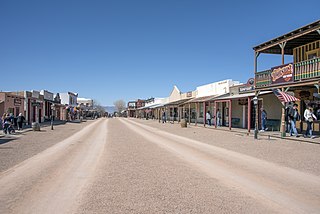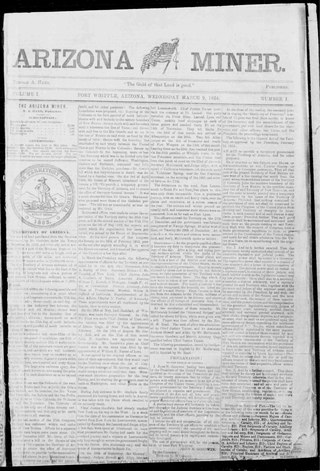
Tombstone is a historic city in Cochise County, Arizona, United States, founded in 1879 by prospector Ed Schieffelin in what was then Pima County, Arizona Territory. It became one of the last boomtowns in the American frontier. The town grew significantly into the mid-1880s as the local mines produced $40 to $85 million in silver bullion, the largest productive silver district in Arizona. Its population grew from 100 to around 14,000 in less than seven years. It is best known as the site of the Gunfight at the O.K. Corral and presently draws most of its revenue from tourism. It also houses the highest-rated brewery in the state of Arizona.

Prescott is a city in Yavapai County, Arizona, United States. According to the 2020 Census, the city's population was 45,827. The city is the county seat of Yavapai County.

Seligman is a census-designated place (CDP) on the northern border of Yavapai County, in northwestern Arizona, United States. The population was 456 at the 2000 census.

Virgil Walter Earp was both deputy U.S. Marshal and Tombstone, Arizona City Marshal when he led his younger brothers Wyatt and Morgan, and Doc Holliday, in a confrontation with outlaw Cowboys at the Gunfight at the O.K. Corral on October 26, 1881. They killed brothers Tom and Frank McLaury and Billy Clanton. All three Earp brothers had been the target of repeated death threats made by the Cowboys who were upset by the Earps' interference in their illegal activities. All four lawmen were charged with murder by Ike Clanton, who had run from the gunfight. During a month-long preliminary hearing, Judge Wells Spicer exonerated the men, concluding they had been performing their duty.

A Western saloon is a kind of bar particular to the Old West. Saloons served customers such as fur trappers, cowboys, soldiers, lumberjacks, businessmen, lawmen, outlaws, miners, and gamblers. A saloon might also be known as a "watering trough, bughouse, shebang, cantina, grogshop, and gin mill". The first saloon was established at Brown's Hole, Wyoming, in 1822, to serve fur trappers.
Skull Valley School District is a school district in Yavapai County, Arizona. It operates a single public K-8 school, Skull Valley Elementary School, in Skull Valley. The school has four teachers and generally 20–30 students. Enrollment in 2017 was 14 students.

Bucket of Blood Street is located off U.S. Route 66 in the Old Downtown district of Holbrook, Arizona. Bucket of Blood Street is one block south of the historical Santa Fe Railroad station on Navajo Road that was built in 1882.

The Courthouse Plaza Historic District is a historic district in Prescott, Arizona that was listed on the U.S. National Register of Historic Places (NRHP) in 1978.
Rochford is an unincorporated community in Pennington County, South Dakota, United States. It is not tracked by the U.S. Census Bureau.
Albert Franklin Banta was an American newspaperman, politician, jurist, and army scout. As a scout, he was a member of the Wheeler Survey and assisted General George Crook during the Apache Wars. Banta was influential in the creation of Apache County, Arizona and later represented the county in the Arizona Territorial Legislature. As a newspaperman, he started and operated a number of papers throughout Arizona Territory.

The Palace Restaurant and Saloon is both the oldest business and oldest bar operating in the state of Arizona, United States. Located on historic Whiskey Row in Prescott, the saloon was opened in 1877, and rebuilt in 1901 after a disastrous fire swept the district in 1900. It is considered one of the most historic bars in the state.
Whiskey Row may refer to:
Gideon Brooke was an American politician and businessman who was a member of the 8th Arizona Territorial Legislature in 1875. He was a local businessman in Yavapai County, Arizona Territory and served on the Yavapai County Board of Supervisors from 1870 to 1873 and again in 1877–1878. In between, he represented Prescott in the legislature at the territory capital Tucson and was chairman of the Committee on Roads and Ferries.

Arizona Miner was a newspaper published in Prescott, Arizona Territory, from 1868 to 1885 and circulated throughout Yavapai County. The paper merged with the Arizona Weekly Journal in 1885 to create the Arizona Weekly Journal-Miner, which was published until 1934. It underwent a succession of owners and changes in its publishing frequency as well as its political leanings.
J. Warren Young was an American politician from Arizona. He served a single term in the Arizona State Senate during the 4th Arizona State Legislature.
Charles Payne Hicks was an American politician from Arizona. He served a single term in the Arizona State Senate during the 4th Arizona State Legislature, holding one of the two seats from Yavapai County.










